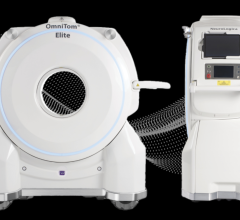
February 8, 2018 — The U.S. Food and Drug Administration (FDA) and the Nuclear Regulatory Commission (NRC) recently took steps to ensure a stable and secure supply of a critical radioactive imaging tracer used to detect potentially life-threatening diseases. The FDA approved the NorthStar Medical Radioisotopes' RadioGenix System, a unique system for producing the medical radioisotope molybdenum-99 (Mo-99), the precurser to the making technetium-99m (Tc-99m), the most widely used radioisotope in medical imaging. The NRC is issuing guidance and will license the RadioGenix System to enable the Tc-99m it produces to be used for medical imaging.
“I’m proud to acknowledge the role the FDA played in the groundbreaking effort to develop a new imaging technology,” said FDA Commissioner Scott Gottlieb, M.D. “This new technology was the result of a broad collaboration across the federal government and industry, and has the potential to benefit many patients as well as restore the U.S. ability to domestically supply a critical medical diagnostic tool for the first time in 30 years."
Tc-99m is a diagnostic agent that is used with single photon emission computed tomography (SPECT) nuclear imaging systems to assess diseases like coronary artery disease and cancer. It is also used for evaluating infection, inflammation, and lung, liver, kidney and brain function. Tc-99m emits radiation that is captured by gamma cameras to produce images of the cellular function inside internal organs. Tc-99m is currently the most widely used medical radioisotope in the United States, used in more than 10 million diagnostic procedures annually. Tc-99m-based radiopharmaceuticals are used to diagnose and stage heart disease, cancer, infection, inflammation and other conditions.
“Every day, tens of thousands of people in the U.S. undergo a nuclear medical imaging procedure that depends on Tc-99m,” said Janet Woodcock, M.D., director of the FDA’s Center for Drug Evaluation and Research. “This radioisotope is vital to disease detection, yet healthcare professionals have faced challenges with adequate supply due to a complex supply chain that sometimes resulted in shortages. Today’s approval has been the result of years of coordination across the FDA and with U.S. government organizations and marks the first domestic supply of Mo-99 — the source of Tc-99m — in 30 years, which will help to ensure more reliable, clean and secure access to this important imaging agent used in nuclear medicine.”
NorthStar said it expects to be shipping product to customers within several weeks of FDA approval. The company said bringing RadioGenix successfully to the U.S. market has been made possible through the support of private commercial investors and the U.S. Department of Energy’s National Nuclear Security Administration. The RadioGenix System is the first major technical advancement in years in the nuclear medicine market, especially for the production of Mo-99.
“As the first, and thus far only company to achieve the objective of being the first U.S. producer of Mo-99 in more than 25 years, we are extremely proud to pioneer domestic production of Mo-99 that is independent of uranium-based product,” said George P. Messina, Chairman and CEO of NorthStar Medical Radioisotopes. “The approval by the FDA will reduce the U.S. healthcare system’s reliance on fragile foreign supply of Mo-99 and the use of enriched uranium target material.”
The Road to Domestic Isotope Production
Tc-99m has been in use as a medical imaging diagnostic agent for decades and is used in more than 80 percent of nuclear medicine imaging procedures in the U.S. Before this recent FDA clearnance, molybdenum-99, or Mo-99, the parent of Tc-99m, could only be produced from enriched uranium by several facilities outside of the United States. This required a complicated supply chain that involved shipping enriched uranium from the U.S. The FDA and NRC said this left the U.S. vulnerable to possible shortages and/or supply chain issues. To address these challenges, Congress enacted the American Medical Isotopes Production Act of 2012, which contained provisions to eliminate the use of highly enriched uranium for medical isotope production and encouraged the development of U.S. domestic supplies of Mo-99 and associated isotopes. As such, multiple federal agencies – including the FDA, NRC, as well as the Department of Energy’s National Nuclear Security Administration (DOE/NNSA) and National Laboratories, among others – have been working together with industry for several years to develop a technology that helps to minimize the industry’s dependence on highly enriched uranium and brings the supply chain within the U.S.
As a result of this collaboration, the U.S. medical community will now have a domestic source of Tc-99m through the use of the RadioGenix System, which marks the first non-uranium process for the production of Mo-99 to prepare the Tc-99m.
As the regulatory authority responsible for overseeing the production, distribution, possession and use of radioactive materials and products containing radioactive materials, NRC is issuing guidance that will advise medical and commercial nuclear pharmacy users on the license amendments they will need to possess and use the RadioGenix System.
"The new technology will reduce the risk of drug shortages and strengthen our national security by creating a U.S.-based manufacturing capacity that is less vulnerable to supply disruptions," Gottlieb said. “Prior to today, the production process for Tc-99m involved shipping enriched uranium out of the U.S. for irradiation. All of the reactors that produced this source material were located outside of the U.S. creating a complicated, at times uncertain, and potentially risky supply chain,” he said.
These foreign facilities were vulnerable to unforeseen shutdowns or closures, deeply impacting the U.S. isotope supply. Additionally, shipping enriched uranium internationally and back was expensive. In some cases, Gottlieb said clinicians shifted to alternative isotopes that may be more expensive or may expose patients to higher radiation doses. This was the case during two supply disruptions in 2009 and 2010 with the temporary closing of the National Research Universal Chalk River reactor in Canada. The reactor, now 60 years old, was shut down for safety reasons and needed repairs and was a major cause for concern in molecular imaging, since that reactor supplied 50 percent of the world’s medical imaging isotopes. There are currently discussions about decommissioning the old Chalk River reactor.
“Simply put, this complicated, international supply chain has been precarious,” Gottlieb explained.
Read the April 2018 article "Chalk River Isotope Reactor Decommissioning Date Set."
NorthStar Has Been Preparing for FDA Clearance
In July 2014, NorthStar Medical Radioisotopes built a 50,000-square-foot facility in Beloit, Wis., to house the company’s headquarters and activities related to the production of Mo-99. The facility is phase one in the planned development of a 32-acre corporate campus. It will support the company’s work at the University of Missouri Research Reactor (MURR) in Columbia, Mo., where NorthStar is developing a neutron capture process to generate Mo-99. The facility will provide ancillary processes, packaging and products, including final assembly and testing of the proprietary RadioGenix intelligent isotope separation system.
Also in 2014, NorthStar signed a non-exclusive letter of intent with GE Healthcare to establish a supply of domestically produced Mo-99 to GE once operations begin.
In 2015, the company unveiled the commercial model of its RadioGenix isotope separation system. The RadioGenix system automates the on-site isotope separation process and includes safety features that are absent from all other systems currently on the market. These features include periodic on-site sterilization of fluid pathways, disposable sterility filters and an automated filter integrity test prior to each elution.
In 2016, NorthStar enhanced its production operations at the MURR, adding a new filling line that quadrupled the company’s capacity there to dispense Mo-99. It was supposed to be fully operational in 2017.
In early 2017, NorthStar received matching funds from the DOE/NNSA for its accelerator method of producing Mo-99. That brought the total funding for the new method to $11.1 million. The award supports the process’ continued advancement toward commercialization and recognizes NorthStar’s progress toward its goal of offering multiple sources of Mo-99 produced in the United States using complementary processes that do not involve highly enriched uranium (HEU).
Production of Sodium Pertechnetate Tc-99m
Today’s FDA actions granted approval for the RadioGenix System to produce sodium pertechnetate Tc-99m injection to be injected intravenously, instilled into the bladder or eye, or used with other FDA-approved imaging drugs to examine specific tissues and organs. This approval did not require new clinical studies because it relied on safety and efficacy information and data from an already FDA-approved Tc-99m generator.
The RadioGenix System allows for automated, on-site separation and preparation of U.S. Pharmacopeia (USP) Sodium Pertechnetate Tc 99m Injection from Mo-99. The RadioGenix is also a platform technology that has the potential ability to apply its separation capabilities at the point-of-care to other radioisotopes in the future, including therapeutic isotopes such as actinium-225/bismuth-213, which will require additional FDA approvals.
The most common side effects of Tc-99m include allergic reactions, including anaphylaxis, that have been reported infrequently following the administration of sodium pertechnetate Tc-99m injection. Healthcare providers should monitor all patients for hypersensitivity reactions.
The FDA said sodium pertechnetate Tc-99m injection contributes to a patient’s long-term cumulative radiation exposure. Healthcare providers should ensure safe handling to protect patients and healthcare workers from unintentional radiation exposure in accordance with instructions for use in the product labeling.
For more information: www.northstarnm.com
Related Content on Tc99m Supply Issues:
FDA Commission's Statement on FDA Clearnace of Northstar's Technology
New Report Finds U.S. Supply of Critical Medical Isotope Vulnerable
Cardiologists Continue Imaging Despite Isotope Shortage by Using Fewer Radiopharmaceuticals
Congress Passes American Medical Isotope Production Act
Producing Medical Isotopes in the U.S.: A Worthy Goal for the Biotech Industry
Time for a New Normal in Nuclear Cardiology?
NorthStar Medical Radioisotopes Signs Letter of Intent With GE Healthcare
Rb-82 Radiotracer Grows at Rapid Rate
NorthStar Medical Radioisotopes Signs Letter of Intent With GE Healthcare
Canada's Nuclear Reactor Down Until 2010
Dutch Medical Isotopes Unavailable Until End of October
Isotope Crisis Highlights Timeliness of SNM Meeting
First U.S. Production Facility of Molybdenum-99 Isotope to be Built in Florida
PET vs. SPECT — Will PET Dominate Over the Next Decade?


 April 16, 2025
April 16, 2025 








